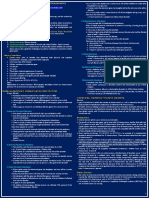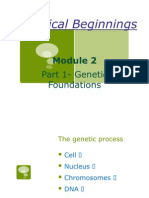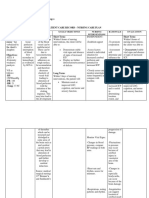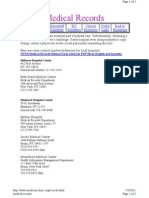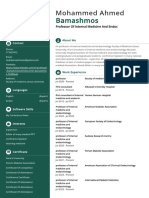0 ratings0% found this document useful (0 votes)
12 viewsDevPsy 1 Prenatal
DevPsy 1 Prenatal
Uploaded by
ninamaedamilesThis document provides an overview of key concepts in developmental psychology related to heredity, prenatal development, and childbirth. It defines key terms like fertilization, zygote, heredity, and chromosomes. It also describes chromosomal abnormalities like Down Syndrome. Prenatal diagnostic tests are discussed, including ultrasound, MRI, and amniocentesis. Genetic inheritance is explained through concepts of alleles, dominance, and genotype-environment interactions. The stages of prenatal development from conception to birth are outlined.
Copyright:
© All Rights Reserved
Available Formats
Download as PDF, TXT or read online from Scribd
DevPsy 1 Prenatal
DevPsy 1 Prenatal
Uploaded by
ninamaedamiles0 ratings0% found this document useful (0 votes)
12 views7 pagesThis document provides an overview of key concepts in developmental psychology related to heredity, prenatal development, and childbirth. It defines key terms like fertilization, zygote, heredity, and chromosomes. It also describes chromosomal abnormalities like Down Syndrome. Prenatal diagnostic tests are discussed, including ultrasound, MRI, and amniocentesis. Genetic inheritance is explained through concepts of alleles, dominance, and genotype-environment interactions. The stages of prenatal development from conception to birth are outlined.
Original Description:
NOTES DEV PSYCH
Original Title
DevPsy_1_Prenatal.docx
Copyright
© © All Rights Reserved
Available Formats
PDF, TXT or read online from Scribd
Share this document
Did you find this document useful?
Is this content inappropriate?
This document provides an overview of key concepts in developmental psychology related to heredity, prenatal development, and childbirth. It defines key terms like fertilization, zygote, heredity, and chromosomes. It also describes chromosomal abnormalities like Down Syndrome. Prenatal diagnostic tests are discussed, including ultrasound, MRI, and amniocentesis. Genetic inheritance is explained through concepts of alleles, dominance, and genotype-environment interactions. The stages of prenatal development from conception to birth are outlined.
Copyright:
© All Rights Reserved
Available Formats
Download as PDF, TXT or read online from Scribd
Download as pdf or txt
0 ratings0% found this document useful (0 votes)
12 views7 pagesDevPsy 1 Prenatal
DevPsy 1 Prenatal
Uploaded by
ninamaedamilesThis document provides an overview of key concepts in developmental psychology related to heredity, prenatal development, and childbirth. It defines key terms like fertilization, zygote, heredity, and chromosomes. It also describes chromosomal abnormalities like Down Syndrome. Prenatal diagnostic tests are discussed, including ultrasound, MRI, and amniocentesis. Genetic inheritance is explained through concepts of alleles, dominance, and genotype-environment interactions. The stages of prenatal development from conception to birth are outlined.
Copyright:
© All Rights Reserved
Available Formats
Download as PDF, TXT or read online from Scribd
Download as pdf or txt
You are on page 1of 7
Developmental Psychology
Heredity, Pre-natal, Childbirth
Source: Papalia (2021), Santrock (2018)
Definition of Terms o Epigenesis – environment can influence when
o Fertilization – also known as conception, is and which genes turn on and off
the process by which sperm and ovum (sex ▪ Refers to chemical molecules attached to a
cells) combine to create a single cell called gene that alter the way a cell “reads” the
zygote, which then duplicates itself again and gene’s DNA
again by cell division. ▪ Cells are susceptible to epigenetic
o Ovulation – rupture of mature follicle in either modification during critical periods such as
ovary and expulsion of its ovum which occurs puberty and pregnancy
every month until menopause Chromosomal Abnormalities
o Dizygotic Twins – also known as Fraternal Name Description Treatment
Twins Extra copy of
Down Surgery,
▪ Two separate eggs being fertilized by two chromosome
Syndrome SPED
different sperms 21
▪ Can be same or different sex Extra X
Klinefelter Hormone
▪ May have genetic basis Chromosome
Syndrome Therapy
o Monozygotic Twins – resulted from the (XXY)
cleaving of one fertilized egg and are generally Abnormality in SPED,
Fragile X
X chromosome Speech
genetically identical Syndrome
causes ID Therapy
o Heredity – genetic transmission of heritable
Missing X
characteristics from parents to offspring Turner Hormone
chromosome
o Deoxyribonucleic Acid – long, spiraling Syndrome Therapy
for females
ladder whose steps are made of pairs of Extra Y
chemical units called bases XXY Syndrome No treatment
chromosome
▪ Adenine, Thymine, Cytosine, Guanine Gene-Linked Abnormalities
o Chromosomes – coils of DNA of smaller Cystic Fibrosis Overproduction Physical
segments called genes of mucus in the Therapy
o Mitosis – cell division of non-sex cells lungs and
o Meiosis – cell division of sex cells digestive tract
o Mutation – mistake in copying genetic code Diabetes Does not Insulin
which creates permanent alteration in genetic produce
material enough insulin
o Autosomes – not affiliated to sexual Hemophilia Delayed blood Blood
expression clotting transfusions
o Sex Chromosomes – 23rd pair which indicates Huntington’s CNS
the baby’s sex (XX, female: XY, male) deteriorates
producing
o Alleles – produce alternative expressions of
problem in
characteristics
muscles and
o Homozygous – if two alleles are the same mental decline
o Heterozygous – if two alleles are different Phenylketonuri Build up of Special Diet
o Dominant – allele that is always expressed or a Phenylalanine
shows up as a trait in that person in the body
o Recessive – usually doesn’t show unless Sickle-Cell Limits body Penicillin,
paired with another recessive trait Anemia oxygen supply Antibiotics,
o Polygenetic Inheritance – interaction of Pain
several genes Reliever
o Phenotype – observable characteristics
o Genotype – underlying genetic makeup
Developmental Psychology
Heredity, Pre-natal, Childbirth
Source: Papalia (2021), Santrock (2018)
Spina Bifida Incompletely Surgery ▪ Niche-Picking – tendency to seek out
closed spinal environments compatible with one’s
canal genotype
Tay-Sachs Accumulation Medication, o Nonshared Environmental Effects – result
Disease of lipids in the Special Diet from the unique environment in which each
NS child in a family grows up
Anencephaly Absence of No treatment o Infertility – inability to conceive a child
brain tissue o In Vitro Fertilization – eggs and sperm are
Polycystic Enlarged Kidney combined in a laboratory dish
Kidney Kidneys Transplant
Disease Prenatal Diagnostic Tests
Alpha Cirrhosis of the No treatment 1. Ultrasound Sonography – high frequency
antitrypsin liver in early
sound waves are directed into the pregnant
Deficiency infancy
woman’s abdomen
Alpha Severe Frequent
Thalassemia Anemia; nearly Blood ▪ No risk to the woman or fetus
all die soon Transfusion ▪ Detect abnormalities, no. of fetuses, and
after birth sex
Beta Severe Blood 2. Fetal MRI – uses powerful magnet and radio
Thalassemia Anemia; fatal Transfusions images to generate detailed images of the
(Cooley’s in adolescence body’s organs and structures
Anemia) or Young 3. Chorionic Villus Sampling – small sample of
adulthood placenta is removed
Duchenne Males with No treatment ▪ Small risk of limb deformity
Muscular muscle 4. Amniocentesis – sample of amniotic fluid is
Dystrophy weakness, withdrawn and tested for chromosomal and
minor mental metabolic disorders
retardation
5. Maternal Blood Screening – identifies
pregnancies that have an elevated risk for birth
o Carriers – carry one bad copy of recessive
defects
gene and one good one
Prenatal Development
o Genotype-Environment Interaction – effects
o Gestation – period between conception and
of similar environment conditions on genetically
birth
different individuals
▪ Between 37 and 41 weeks
o Genotype-Environment Correlation –
▪ Gestational Age: dated from the first day of
environment often reinforces genetic
an expectant mother’s last menstrual cycle
differences
Stages of Prenatal Development
a. Passive Correlations: parents tend to
o Cephalocaudal Principle – development
provide environment that encourages the
proceeds from head to the lower extremities
development of that trait
o Proximodistal – development proceeds from
b. Reactive or Evocative: children with
the center to outer parts of the body
differing genetic makeups evoke different
reactions from others, other people react to Early Signs and Symptoms of Pregnancy
Tender, Swollen breasts or nipples
the children’s genetic makeup
Fatigue
c. Active: actively selects or create
Slight bleeding or cramping
experiences consistent with their genetic
Food Cravings
tendencies
Nausea with or without vomiting
Frequent Urination
Developmental Psychology
Heredity, Pre-natal, Childbirth
Source: Papalia (2021), Santrock (2018)
Frequent, Mild Headaches o From 8 weeks to Birth
Constipation o Appearance of the first bone cells
Mood Swings o Final stage of gestation
Faintness and Dizziness o Grows rapidly to about 20x its previous length
Raised Basal Body Temperature o Finishing touches
Germinal Stage o Breathe, kick, turn, etc.
o From fertilization to about 2 weeks of o Facial expressions of pain at 36 weeks
gestational age o Responds to mother’s voice
o Zygote enters into cell division (mitosis) while o Fetuses know when they approach the near
making its way to the fallopian tube end of the pregnancy
o Differentiation – specialization of the cells to o Grasping reflex
perform various tasks o 6 months or more fetuses can survive outside
o Blastocyst – fluid-filled sphere which floats the womb
freely in the uterus until 6th day after fertilization o 24-37 months babies need help in breathing
then it implants itself in the uterine wall Environmental Influences
o Trophoblast – outer layer of cells that later o Teratogen – environmental agent that can
provides nutrition and support for the embryo interfere with normal prenatal development
o Ectoderm – outer layer (becomes outer layers o Teratology – field of study that investigates the
of skin, nails, hair, teeth, sensory organs, and causes of birth defects
the nervous system) Nutrition Maternal Weight
o Endoderm – inner layer (becomes digestive o Women of normal weight are less likely to have
system) birth complications
o Mesoderm – middle layer (becomes inner o Overweight women have risk of having longer
layers of skin, muscles, skeleton, and excretory deliveries, need more health care services,
and circulatory systems) gestational diabetes, cesarean delivery, birth
o Amniotic Sacs – encloses the developing defects etc.
embryo, protecting it and giving it a room and o Omega-E, DHA, Folic Acid for the development
grow of nervous system
o Placenta – allows oxygen, nourishment, and Malnutrition
wastes to pass between mother and embryo o Results to fetal growth restriction and low birth
o Umbilical Cord – connects the embryo to the weight
placenta Physical Activity and Work
Embryonic Period o Moderate exercise is recommended to reduce
o From 2 to 8 weeks (First 2 monts) back pain, risks for gestational diabetes and
o Major body systems (respiratory, digestive, and etc.
nervous system) develop known as Drug Intake
Organogenesis o Thalidomide – caused stunted limbs, facial
o Critical Period – most vulnerable to destructive deformities, and defective organs
influences o Another set of drugs that are harmful for
o Spontaneous Abortion (Miscarriage) – pregnant women: Antibiotics, certain
expulsion from the uterus of an embryo that is Barbiturates, Opiates, Acutane
unable to survive outside the womb o Opioids are associated with small babies, fetal
o Stillbirth – miscarriage occurred after 20 death, preterm labor, and aspiration of
weeks of gestation (approx. 5 months) meconium
o Males are more likely to be spontaneously o Babies born with drug-addicted mothers tend to
aborted or to be stillborn experience withdrawal once they are born and
Fetal Period no longer receive drugs
Developmental Psychology
Heredity, Pre-natal, Childbirth
Source: Papalia (2021), Santrock (2018)
o Neonate Abstinence Syndrome – sleep o Babies who fathers had diagnostic x-rays
disturbance, tremors, difficulty regulating the within the year prior to conception or had a
body, irritability, crying and etc. high lead exposure at work tends to have low
o Fetal Alcohol Syndrome – characterized by a birth weight and slowed fetal growth
combination of retarded growth, face and body o Older fathers may be significant source of birth
malformations, and disorders of the central defects due to damaged or deteriorated sperm
nervous system such as dwarfism, schizophrenia, bipolar
o Maternal smoking was identified to be the most disorder, ASD
important factor for low-birth weight babies Prenatal Care
o Tobacco also increases the risks of o Prenatal cell-free DNA Scans – fetal DNA is
miscarriage, growth retardation, stillbirth, SIDS, extracted from the mother’s blood and tested
etc. for early detection of genetic problems
o Caffeine has slightly increased risk for Birth Process
miscarriage, stillbirth, and low birth weight o Labor – process of giving birth
babies o Parturition – series of uterine, cervical, and
o Rubella almost certain to cause deafness and other changes which begins 2 weeks before
heart defects to babies the delivery
o Toxoplasmosis – caused by parasite in the o Braxton-Hicks Contractions – false
bodies of cattle, sheep, and pigs, and in the contractions
intestinal tracts of cats that causes fetal brain o Real labor contractions are more frequent,
damage, severely impaired eyesight, seizures, rhythmic, and painful, and they increase in
miscarriage, etc. frequency and intensity
o Diabetic mothers are most likely to have babies Stages of Birth
that have heart and neural tube defects First Stage (Dilation of the Cervix)
Maternal Anxiety, Stress, and Depression Longest stage
o Stress and anxiety has been associated with Contractions are 15 to 20 mins apart
more irritable and active temperament in Cervix opened about 10cm
newborns For first born, it can last for 6-12 hrs, then shorter
o Chronic stress can result in preterm delivery for the next children
o Depression may cause premature birth or Second Stage (Descent and Emergence of the
developmental delays Baby)
Maternal Age Baby’s head starts to move through the cervix
o Chance of miscarriage or stillbirth rises with Baby is coming out
maternal age Approx. 45 mins to hr
o Adolescent Mothers tend to have premature or Third Stage (Expulsion of the Placenta)
underweight babies Afterbirth
Outside environmental Hazards Placenta, Umbilical cord, and other membranes
detached and expelled
o Includes air pollution, radiation, chemicals
Shortest stage
o Fetal exposure to low level of environmental
toxins may result to asthma, allergies, lupus
o Midwifery – profession that provides health
o X-Rays could triple the risk of having full-term,
care to women during pregnancy, birth, and
low-birth weight babies
even postpartum period
Paternal Factors
o Doula – caregiver who provides continuous
o Exposure to lead, marijuana, tobacco,
physical, emotional, and educational support
radiation, pesticides, etc may result in
for the mother before, during, and after
abnormal or poor quality sperm
childbirth
Developmental Psychology
Heredity, Pre-natal, Childbirth
Source: Papalia (2021), Santrock (2018)
Methods of Childbirth ▪ Breech Position – baby’s buttocks are
o Electronic Fetal Monitoring – used to track the first part to emerge from the vagina
the fetus’ heartbeat during labor and delivery which can cause respiratory problems
and to indicate how the fetal heart is ▪ Complications: bleeding, infection,
responding to the stress of uterine contractions damage to pelvic organs, post-operative
▪ can provide valuable information in pains, riskier future pregnancies
high-risk deliveries
▪ extremely high false-positive rate
o Three kinds of drugs are used for labor:
a. Analgesia – pain reliever such as
tranquilizers, barbiturates, and narcotics
b. Anesthesia – used in the late first stage
labor and during delivery to block sensation
in an area of the body or to block
consciousness
▪ Epidural Block – regional anesthesia
that blocks the lower part of the body
▪ Pudendal Block – vaginal anesthesia
c. Oxytocin – hormone that promotes
contraction (Pitocin)
o Natural Childbirth – method that aims to
reduce the mother’s pain by decreasing her
fear by providing information about childbirth
and teaching her and her partner to use
breathing methods and relaxation techniques
during delivery Assessing the Newborn
o Bradley Method – husbands as coaches, o APGAR Scale – widely used to assess the
relation for easier birth and prenatal nutrition health of newborns at 1-5 mins after birth
and exercise
o Prepared Childbirth or Lamaze method –
special breathing technique to control pushing
in the final stages of labor
o Vaginal Delivery – usual childbirth
o Benefits: surge of hormones that clear the
lungs and excess fluid, mobilize stored fuel
to nourish cells, and send blood to the heart
and brain
o Cesarean Delivery – baby is removed from
the mother’s uterus through an incision made ▪ 7-10, condition is good
in her abdomen ▪ 5, developmental difficulties
▪ Performed if the baby is lying crosswise, ▪ 3 or below, emergency and the baby might
if the baby’s head is too large, not survive
complications, or if the mother is ▪ 9-10 score, risk of developing ADHD in
bleeding internally childhood
▪ Not recommended prior to 39 weeks of o Brazelton Neonatal Behavioral Assessment
gestation unless there is an indication of Scale – performed within 24-36 hrs after birth
fetal lung maturity
Developmental Psychology
Heredity, Pre-natal, Childbirth
Source: Papalia (2021), Santrock (2018)
to assess neurological development, reflexes, o Kangaroo Care – involves skin-to-skin contact
and reactions in which the baby, wearing only diaper, is held
o Neonatal Intensive Care Unit Network upright against the parent’s bare chest to help
Neurobehavioral Scale – assessment of the stabilize the preterm’s heartbeat, temp, and
newborn’s behavior, neurological and stress breathing
response, and regulatory capacities o One condition commonly faced by preterm
o Newborn Screening for Medical Conditions babies is Respiratory Distress Syndrome
- check for rare genetic, hormone-related, and wherein there is a lack of surfactant
metabolic conditions that can cause serious (lung-coating substance) that keeps air sacs
health problems from collapsing
o Boys tend to be slightly longer and heavier o Postmature Babies – tend to be long and this
than girls because they have kept growing in the womb
o First born weigh less that laterborns but have had an insufficient blood supply
o Fontanels – where the bones of the skull don’t toward the end of gestation
meet o Sudden Infant Death Syndrome – crib death;
o Lanugo – fuzzy prenatal hair sudden death of an infant under age 1 which
o Vernix Caseosa – oily protection against cause of death remains unexplained
infection that dries within the first few days Postpartum Period
o Anoxia – lack of oxygen o Period after childbirth
o Hypoxia – reduced oxygen supply o Lasts for about 6 weeks or until the mother’s
o Anoxia or Hypoxia may occur during delivery body has completed the adjustment and
as a result of repeated compression of the returned to nearly prepregnant state
placenta and umbilical cord that could leave Physical Adjustment
permanent brain damage, mental retardation, o Loss of sleep that the primary caregiver
behavior problems or even death experiences during this period
o Meconium – stringy, greenish-black waste o Sudden and dramatic hormone production
matter formed in the fetal intestinal tract o Estrogen and progesterone levels drop steeply
o Neonatal Jaundice – skin and eyeballs look and remain low until the ovaries start producing
yellow caused by immaturity of the liver again
Pre-term and Low Birth Weight Infants Emotional and Psychological Adjustment
o Low Birth Weight Infants – weigh less than 5 o Emotional fluctuations are common
pounds and 8 ounces at birth o Postpartum Blues – 2-3 days after birth they
▪ Very Low birth Weight – less than 3 feel depressed, anxious, and upset
pounds 4 ounces o Postpartum Depression – involves a major
▪ Extremely Low Birth – less than 2 pounds depressive episode that typically occurs about
o Pre-term Infants – born three weeks or more four weeks after delivery or at least a two-week
before pregnancy reach full term (before the period of having trouble coping with their daily
completion of 37 weeks of gestation) task
o Small for Date Infants (Small for Gestational o Postpartum Depression could affect how the
Age Infants) – those whose birth weight is mother interacts with her infant
below normal when the length of pregnancy is o Fathers may also experience depression or
considered they may feel replaced by the baby
o Progestin – might help in reducing preterm Bonding
birth o Formation of connection, especially a physical
o Extremely Preterm – born less than 28 weeks bond between parents and the newborn in the
gestation period shortly after birth
o Very Preterm – less than 33 weeks
Developmental Psychology
Heredity, Pre-natal, Childbirth
Source: Papalia (2021), Santrock (2018)
o Newborn MUST have close contact with the
mother in the first few days of like to develop
optimally is NOT true
End - amsl
You might also like
- ANSWERDocument2 pagesANSWERNicole Anne CamamaNo ratings yet
- DevPsy 1 PrenatalDocument6 pagesDevPsy 1 PrenatalChristian 07No ratings yet
- DevPsy 1 PrenatalDocument6 pagesDevPsy 1 PrenatalTaguro MoonNo ratings yet
- DevPsy 1 PrenatalDocument6 pagesDevPsy 1 PrenatalIvy Marie ToyonganNo ratings yet
- DevPsy 1 PrenatalDocument6 pagesDevPsy 1 PrenatalChristian 07No ratings yet
- Devpsych Reviewer 1Document56 pagesDevpsych Reviewer 1Joshua MalloNo ratings yet
- Chapter 3. DevpsychDocument7 pagesChapter 3. DevpsychEdralyn EgaelNo ratings yet
- Chapter 3Document9 pagesChapter 3Rae Ann FeguracionNo ratings yet
- Maternal Notes PrelimDocument13 pagesMaternal Notes PrelimyueNo ratings yet
- DEVPSYCH 3 - Forming A New LifeDocument4 pagesDEVPSYCH 3 - Forming A New LifeRedgie G. GabaneNo ratings yet
- Week 4 - Human GeneticsDocument5 pagesWeek 4 - Human GeneticsTEDDY BEAR PRODUCTIONNo ratings yet
- Namma Kalvi 12th Bio-Zoology Unit II Surya Biology Guide emDocument75 pagesNamma Kalvi 12th Bio-Zoology Unit II Surya Biology Guide emDhanush RamanNo ratings yet
- Patterns of InheritanceDocument26 pagesPatterns of InheritanceVidhya NairNo ratings yet
- Concept of Unitive and Preventive HealthDocument5 pagesConcept of Unitive and Preventive HealthalorNo ratings yet
- B. Concepts in Genetics335Document14 pagesB. Concepts in Genetics335owenspros5No ratings yet
- Medical GeneticsDocument58 pagesMedical GeneticsJames JohnsonNo ratings yet
- Proreation and Genetic Disorder 2Document9 pagesProreation and Genetic Disorder 2coosa liquorsNo ratings yet
- 4M GeneticsDocument12 pages4M GeneticsAubrey Justine GaleonNo ratings yet
- Reproduction Notes Biol1008 ANUDocument14 pagesReproduction Notes Biol1008 ANUAbby FaureNo ratings yet
- Agents of DiseasesDocument3 pagesAgents of DiseasesRaymart DomingoNo ratings yet
- Gen Bio AiaDocument13 pagesGen Bio AiaNAQUITA, NORGAIL AIA M.No ratings yet
- CMCR Reviewer Ni GandaDocument8 pagesCMCR Reviewer Ni GandaMay RodeoNo ratings yet
- Care of Mother, Child, at Risk With Problems NotesDocument8 pagesCare of Mother, Child, at Risk With Problems NotescelinaNo ratings yet
- HEREDITY - Crash Course Biology #9Document2 pagesHEREDITY - Crash Course Biology #9M. Corales, Adrian Neil B.No ratings yet
- Physio Chap 4-7Document33 pagesPhysio Chap 4-7M. Corales, Adrian Neil B.No ratings yet
- Intro To Genetics DiseasesDocument3 pagesIntro To Genetics DiseasesKhaldoun AlmomaniNo ratings yet
- Chapter 5: InheritanceDocument21 pagesChapter 5: Inheritanceridwan100% (2)
- Genetic DisordersDocument30 pagesGenetic DisordersLawrence DubeNo ratings yet
- Cytogenetics Lecture 07Document7 pagesCytogenetics Lecture 07Dianne NolascoNo ratings yet
- Bio 2 - MidtermsDocument3 pagesBio 2 - MidtermsSofia EgbalicNo ratings yet
- Science TestDocument2 pagesScience TestNaveed MendezNo ratings yet
- Basic Terms in Genetics - 022246 2Document15 pagesBasic Terms in Genetics - 022246 2SamadNo ratings yet
- Session 1-1 InheritanceDocument20 pagesSession 1-1 InheritancejoNo ratings yet
- Ob1 Sas 4Document11 pagesOb1 Sas 4tmsollano04No ratings yet
- Science Reviewer - Docx 1Document4 pagesScience Reviewer - Docx 1marcjohncaelNo ratings yet
- BIOL 223-Genetics-Sexual Reproduction and MeiosisDocument31 pagesBIOL 223-Genetics-Sexual Reproduction and Meiosispfpssmpc95No ratings yet
- Chapter 5Document7 pagesChapter 5Jesslyn YongNo ratings yet
- Heredity For JHSDocument21 pagesHeredity For JHSKrisnhaliani100% (1)
- Sexual Reproduction Gene ReassortmentDocument20 pagesSexual Reproduction Gene Reassortmentronwest1990No ratings yet
- 5 Non Mendelian GeneticsDocument25 pages5 Non Mendelian Genetics2021-204943No ratings yet
- Abpsych NeuroscienceDocument7 pagesAbpsych Neuroscience2020-101143No ratings yet
- Developmental Psy 1Document26 pagesDevelopmental Psy 1Sonia SoansNo ratings yet
- BIO 2 2nd SemDocument7 pagesBIO 2 2nd SemKelly Misha NoolNo ratings yet
- Cytogen Lesson 1Document3 pagesCytogen Lesson 1STEM-A CHRISTINE TRIBUNALONo ratings yet
- Mendelian and Non Mendelian GeneticsDocument75 pagesMendelian and Non Mendelian GeneticsColesio, Maria Elaine M.No ratings yet
- Chapter 5 - Reviewer - Biological PsychologyDocument6 pagesChapter 5 - Reviewer - Biological PsychologyGloriel Grace DoromalNo ratings yet
- Genetics and Human Development: General PsychologyDocument74 pagesGenetics and Human Development: General PsychologyJohn Paul BasiñoNo ratings yet
- Ncma219 Ob Lec: BSN 2Nd Year 2Nd Semester Prelim 2022: Bachelor of Science in Nursing 2YBDocument59 pagesNcma219 Ob Lec: BSN 2Nd Year 2Nd Semester Prelim 2022: Bachelor of Science in Nursing 2YBEARL GERALD RICAFRANCANo ratings yet
- PATHOPHYSIOLOGY II (Mumtaz Ali Khan)Document61 pagesPATHOPHYSIOLOGY II (Mumtaz Ali Khan)Qmobile swatNo ratings yet
- Genetika ManusiaDocument35 pagesGenetika ManusiaWndy 0903No ratings yet
- Genetics Notes 1Document7 pagesGenetics Notes 1Hi HiNo ratings yet
- Genetics Lec ReviewerDocument4 pagesGenetics Lec ReviewerdiezelNo ratings yet
- Human Genetics - DR RashaDocument58 pagesHuman Genetics - DR RashaRasha TelebNo ratings yet
- MCN1 Sas 4Document10 pagesMCN1 Sas 4Vendheyl LegaspiNo ratings yet
- DocumentDocument4 pagesDocumentALi AL-kwafiNo ratings yet
- Genetics & InheritanceDocument5 pagesGenetics & InheritanceClaraNo ratings yet
- Biology - Brain (Genes and The Brain)Document6 pagesBiology - Brain (Genes and The Brain)Teacă Mădălina ElenaNo ratings yet
- You Are Unique : An Introduction to Genetics - Biology for Kids | Children's Biology BooksFrom EverandYou Are Unique : An Introduction to Genetics - Biology for Kids | Children's Biology BooksNo ratings yet
- Infant Gender Selection & Personalized Medicine: Consumer's GuideFrom EverandInfant Gender Selection & Personalized Medicine: Consumer's GuideNo ratings yet
- Unit 1 Admission: A. ExpressionDocument6 pagesUnit 1 Admission: A. ExpressionNabila NurfadillaNo ratings yet
- Flyer Jiccim Fix1Document7 pagesFlyer Jiccim Fix1Annisa SuhermanNo ratings yet
- PHC 202 Three Year Strategic PlanDocument14 pagesPHC 202 Three Year Strategic PlanSarah Agudo FernandezNo ratings yet
- Devesh CV - MSLDocument1 pageDevesh CV - MSLSatish SrivastavaNo ratings yet
- NCP #1 Ineffective Cerebral Tissue PerfusionDocument4 pagesNCP #1 Ineffective Cerebral Tissue PerfusionsteffiNo ratings yet
- Medical Records NYCDocument3 pagesMedical Records NYCgwapingMDNo ratings yet
- BSN Oliveros, Leoneil B. Reading HypothyroidismDocument7 pagesBSN Oliveros, Leoneil B. Reading HypothyroidismleoNo ratings yet
- Independent Practice IssuesDocument11 pagesIndependent Practice IssuesYamanika Abe100% (1)
- The Medical Act of 1959Document14 pagesThe Medical Act of 1959Czara DyNo ratings yet
- Lesson Plan On Cervical CancerDocument11 pagesLesson Plan On Cervical CancerManisha David100% (1)
- Mal OcclusionDocument24 pagesMal OcclusionKelly YeowNo ratings yet
- Neurofibromatosis Involving The Fibula in An Adult Patient: Case ReportDocument3 pagesNeurofibromatosis Involving The Fibula in An Adult Patient: Case ReporthardiNo ratings yet
- Professor Mohammed Ahmed Bamashmos CVDocument7 pagesProfessor Mohammed Ahmed Bamashmos CVMohammed Ahmed BamashmosNo ratings yet
- Introduction To Health Assessment ConceptsDocument29 pagesIntroduction To Health Assessment ConceptsZeshanNo ratings yet
- Medical Record Audit Tool PDFDocument4 pagesMedical Record Audit Tool PDFnurhaidah89% (9)
- Maxicare Provider Dental HubDocument52 pagesMaxicare Provider Dental HubClarissa Anne Julian-SanchezNo ratings yet
- Department of Health (DOH) Deployment Program: RationaleDocument37 pagesDepartment of Health (DOH) Deployment Program: RationaleJerome CidNo ratings yet
- CBDRP Reporting Form 1Document1 pageCBDRP Reporting Form 1Edward Aguirre PingoyNo ratings yet
- Ethics of Johnson & JohnsonDocument2 pagesEthics of Johnson & Johnsonanirudhpatel2580No ratings yet
- Course Specification Template EmergencyDocument6 pagesCourse Specification Template EmergencyWael LotfyNo ratings yet
- Clinical Risk Index For Babies (Crib) Ii Score As A Predictor of Neonatal Mortality Among Low Birth Weight Babies at Kenyatta National HospitalDocument6 pagesClinical Risk Index For Babies (Crib) Ii Score As A Predictor of Neonatal Mortality Among Low Birth Weight Babies at Kenyatta National HospitalVladBadeaNo ratings yet
- Emergency Contraceptive Knowledge, Attitudes and Practices Among Female Students at The University of Botswana: A Descriptive SurveyDocument6 pagesEmergency Contraceptive Knowledge, Attitudes and Practices Among Female Students at The University of Botswana: A Descriptive SurveyNaveed AhmadNo ratings yet
- Stroke Hemoragik (DR - Dr. Syahrul, SPS (K) )Document25 pagesStroke Hemoragik (DR - Dr. Syahrul, SPS (K) )YogaNo ratings yet
- VIVITROLPrescribing InfoDocument11 pagesVIVITROLPrescribing InfoHarish RathodNo ratings yet
- Journal DermatologyDocument8 pagesJournal DermatologyImelva GirsangNo ratings yet
- Isoniazid-Induced Acute Psychotic Episode in A Child With Lymph Nodes Tuberculosis: Case Report and Literature ReviewDocument11 pagesIsoniazid-Induced Acute Psychotic Episode in A Child With Lymph Nodes Tuberculosis: Case Report and Literature ReviewIJAR JOURNALNo ratings yet
- COP 3 & PFR 1.5 - Care of Vulnerable Patients 2Document3 pagesCOP 3 & PFR 1.5 - Care of Vulnerable Patients 2n_robinNo ratings yet
- Pekelililing-PSM GuidanceDocument21 pagesPekelililing-PSM GuidanceTZ LAB100% (1)
- Introduction To Pharmacy and Pharmacy Law SyllabusDocument7 pagesIntroduction To Pharmacy and Pharmacy Law SyllabusNouran MagdyNo ratings yet






















